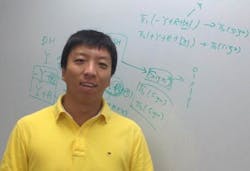Columbia, MO--Using the GPS and imaging abilities from a smartphone, University of Missouri (MU) researchers have developed new software that determines the exact location of distant objects and also monitors the speed and direction of moving objects. The photonics software could eventually allow smartphone-armed soldiers to target the location of their enemies. On the home front, the software could be used by everyone, including golfers judging distance to the green and biologists documenting the location of a rare animal without disturbing it (or football fans tracking their favorite player).
"The great advantage of a smartphone is that it provides so many tools in a single, readily available, relatively inexpensive package," said Qia Wang, a doctoral student in MU's College of Engineering who led the development of the software. "For example, on the battlefield, a soldier needs a rangefinder, compass, GPS and other tools to do reconnaissance before calling in an air strike. With our software, the soldier can have all those instruments in one device that can be purchased off the shelf. When that soldier returns from war, [he or] she can use the same software to protect [his or] her family by clocking a speeder near [his or] her children’s school and catching the culprit on video."
Wang and his colleagues developed their software to locate and track targets of known and unknown size. When the size of the target is known, a single image is enough to pinpoint the target’s location. The software computes the latitude and longitude of the target using the smartphones’ GPS location, compass reading, and the distance to the target based on the relative size of the target in the image compared to its known real-life size. If the exact size of a target is unknown, the software uses two images to triangulate the location of the target. It can also track moving targets. By taking a short video of a moving target, the smartphone software can calculate how fast the target is moving and in what direction it is going.
"Currently, our software is limited by the physical abilities of smartphone hardware, but the devices are improving rapidly," Wang said. "We anticipate that improvements in GPS accuracy, battery life and camera resolution will allow our software to make even more accurate observations. We also are making our software more user-friendly."
The targeting and tracking software is not available commercially yet. A prototype version has been created and is currently being tested. More algorithms and methods are being developed to improve the speed and accuracy. Details on the programming and functionality of the software were presented by Wang and his colleagues at the Geospatial InfoFusion II conference and published in the Proceedings of SPIE.
SOURCE: University of Missouri; http://munews.missouri.edu/news-releases/2012/0830-smartphone-app-can-track-objects-on-the-battlefield-as-well-as-on-the-sports-field-says-mu-researcher/

